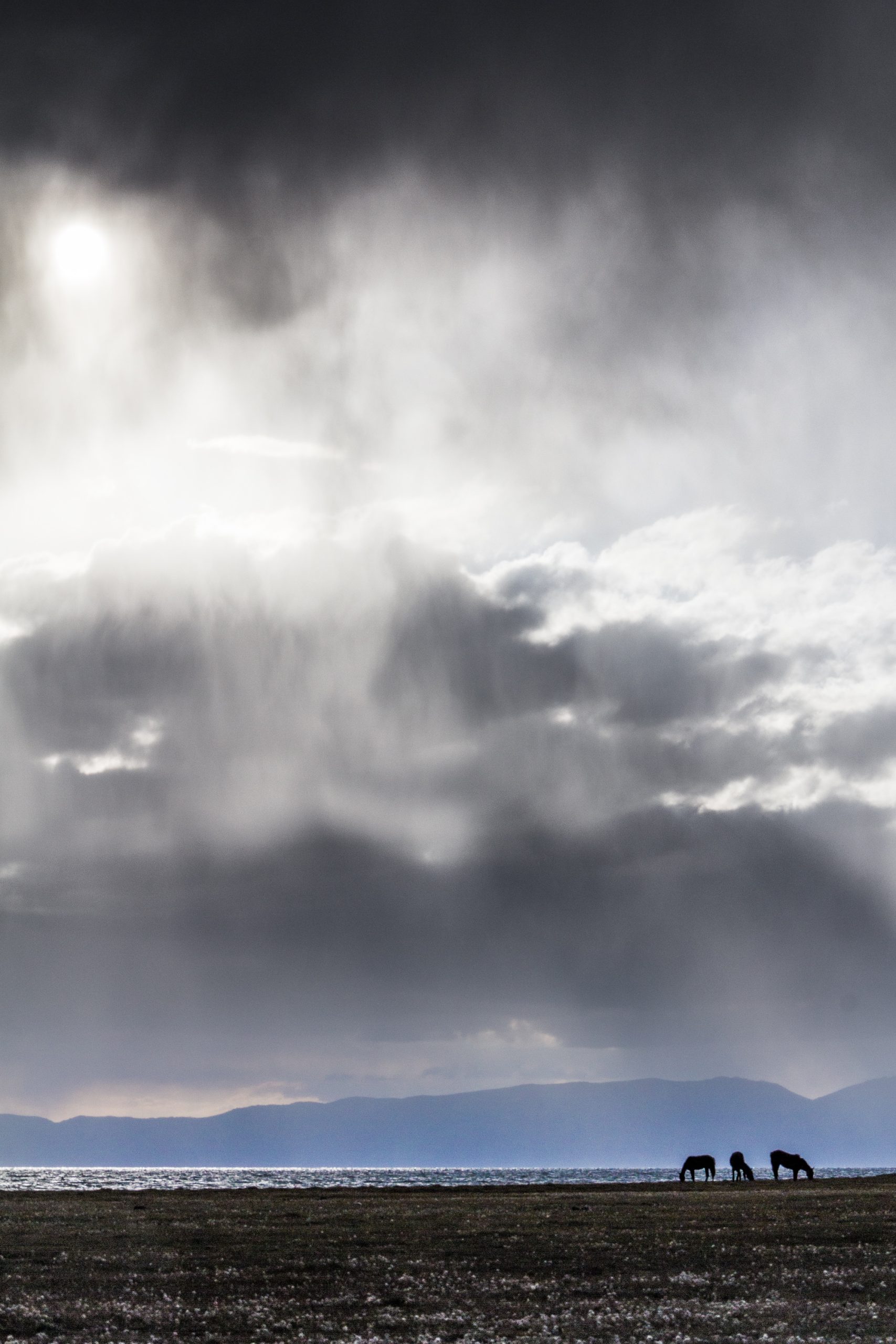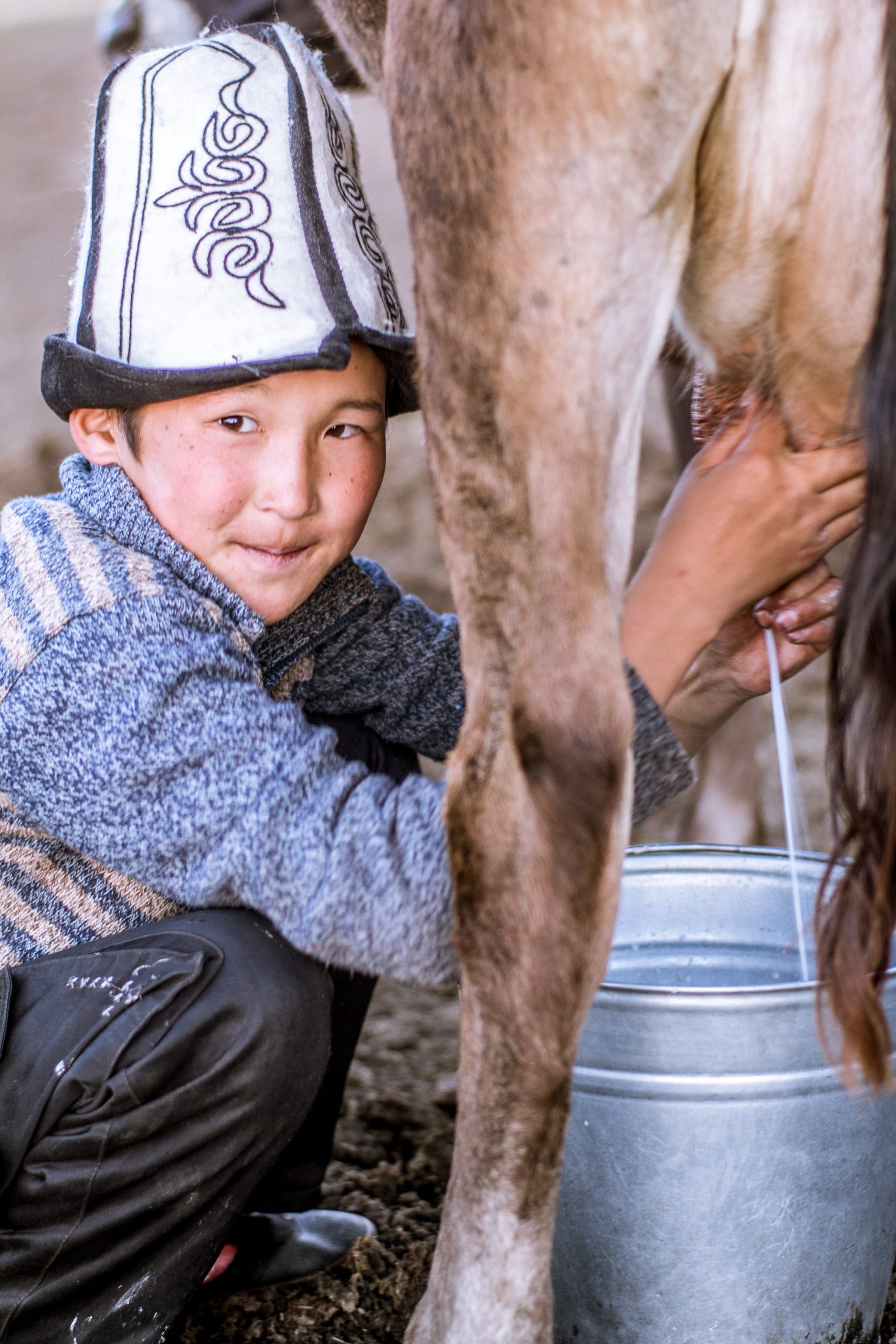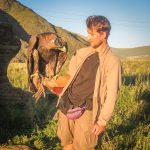“We’ll be heading for Kyrgyzstan!”
Very often this quote caused frowning eyebrows, followed by an astonished “Where?”,“What are you going to do there?”, and “What is there to see?” an “Why do you call this your holiday”
Daily life in the main towns of Kyrgyzstan

Next-gen Kyrgyz (power) rangers

If not my horse, my donkey or Lada will do!

The endless landscape and a lone shepherd
Are there any real nomads in Kyrgyzstan or do they just put up a circus act to attract curious (Western) tourists?
Once landed in Bishkek, we traveled with one of the “wait-till-it’s-full-minivans” to the east side of the Issyk-Kul lake, to the city of Karakol. In the magnificent mountains; we encountered beautiful landscapes, rough swirling rivers, but no nomads,… except for the actors and film-crew of Kurmanjan datka. The only ‘real’ people were modern Kyrgyz families enjoying their Sunday picnic in the meadows, which were easily accessible by …car. Where are those nomad’s herding their cattle on their horse?

A posing actor .

lunch-time in the Kyrgyz movie industry

An old Lada discovering new paths
The next day we left for an adventurous trekking in a part where the weather changed faster than we could change our clothes. Gushing rain, a welcome sunshine, followed by hide-in-your-tent-snow-storm, to end with a swirling wind.
This just made us realize even more that a nomad’s life in these mountains was everything but easy.
But did we find real nomads in this mountain range? Not as we imagined…

A horse waiting for his master or his bets friend.

The hard, but beautiful natural wonders in the Karakol mountains
A new hope rose when a local guide of the Karakol CBT office told us where there was a bigger chance to observe (and participate in) the nomadic life. Bokonbaevo was waiting for us. Even better than expected, there was a nomadic festival where tourists could experience the traditional culture of the Kyrgyz nomads with all the ingredients you need: Yurts, birds of prey, horse-wrestling, traditional singing and dancing, and delicious plov. It was nice to see how even the young Kyrgyz men and women were proud of their culture and eager to show off their skills.

A horse waiting for his master or his bets friend.

Wrestling boys…on their horse

A hunters’ eagle to… hunt

The falcon of prey
The next day we left for a three day trekking in the panoramic mountains surrounding Bokonbaevo. Hoping that the wonderful acts of the preceding day came from the deepest of their Kyrgyz heart. The first stop was a disappointment at first sight; a house (accessible by car) with a Yurt next to it, reserved for the lost tourist.
Our lovely babouchka-host in her outside kictchen.
Once we came closer we directly felt the warmth of our hosts’ heart. A food-covered table was waiting us and the — in their point of view — best parts of the meat were served accompanied by hot tea. As the television was playing a Pierce-Brosnan-James-Bond-scene we heard a sharp distracting sound outside.
‘That’s just the eagle screaming and waiting for his master to feed him’ as it was the most common answer you’ve heard.

A room with a view.

James bond in and against the USSR.

Our wonderful first yurt-night .

An eagle and his mankind.
Apparently the man of the house was an expert in eagle hunting, a traditional way of hunting that he learned from his father, a great late eagle-hunter. The relationship between hunters and their eagle is a true connection with nature.
They grab the young eagle out of the nest, whilst risking their own life on some cliffs’ edge under attack by the eagle-mother.
They feed them, raise them and even sing to them so a real bond is created between man and eagle. Hunting is primary done in winter when the prey is better noticeable in the snow and plumped up for the hard winter time. After a few years they release the eagle in nature and start the process again.
This was a pleasant encounter with an unfortunately dying old tradition. The call of the smartphones and wi-fi is getting more interesting for the Kyrgyz adolescents than the call of nature.
The panoramic colourful hills around Bokonbaevo.
This was a pleasant encounter with an unfortunately dying old tradition. The call of the smartphones and wi-fi is getting more interesting for the Kyrgyz adolescents than the call of nature.
The day after we hiked our way up with our horse (who carried the bags) and guide (who guided and showed us the way) to look for another Kyrgyz family further up in the mountains or ‘jailoo’
In the late afternoon we saw two yurts waiting for us with a very warm welcoming tea and a first encounter with ‘kumis’

The horses never go far away from their foals, who stay close to the yurts

Cows and horses are milked twice a day
‘Kumis’ is the result of fresh horse milk, preserved in a leather bag, where the fermentation process starts. After a few days and some passionate churning movements, a slightly alcoholic beverage is ready to be served.
The night falls and as guests we are honored with a lovely meal and traditional Kyrgyz music. Songs were shared, followed by roars of laughter, more ‘kumis’ and fresh yogurt as dessert.

Our host with his traditional Kyrgyz hat.

Guests are honored with ‘kumis’ and traditional music.

The lovely hospitable grandmother.

This kid enjoyed our presence and showed us his musical skills.
A new morning meant a new farewell to people who now occupied a place in our hearts.
Next stop: Song-Kul
A lake where nomads’ livestock has been grazing every summer since ages. “Easy-accessible infinite yurts around the lake” is what our local guide promised.
Reaching the last top of the hill we saw the lake from far, surrounded by multiple yurts and the cattle running around freely.

laundry day at the yurt camp.

Milking the cows; something this little girl was proud of, since it was her first time
Once we reached the yurt of our host, it was time for the classical (and still welcome) bread with jam and tea. The landscape with the stormy weather — accompanied by rays of sun — was brilliant, but something was missing. We walked around and saw other Western tourists, the locals looked at us with a friendly smile but lacked a curious look in their eyes when they saw us with our guide. That’s the moment we understood:
We are too late: the real nomadic life around this lake had evolved into a tourism business
Thunder is coming, horses are fierce!
Our guide appointed us one of the numerous yurts where we could sleep, told us when dinner would be served — not in the same yurt as the host — and we synchronized watches to make sure we wouldn’t miss our transport back to the nearest town.
We decided to make the best of it and started to explore the near surroundings of our yurt.
Luckily for us the local people tended to be much nicer than our guide made us believe.
The evening fell and we saw how the shepherds were gathering their cattle, the cows being milked, and the livestock being prepared to live through the night safely.

A shepherd riding his donkey to collect his cattle.

At the Song-Kul lake, the rain is never far away.

In Kyrgyzstan, every car can be a taxi.
This was a moment that we understood that our guide was nothing more than a walking map. Someone who didn’t understand the nomadic life and, as being a Kyrgyz, didn’t respect his origin. We understood that if you show your honest interest in the nomadic way of living, they reward you with a place in their heart.

Our helpful guide only spoke Kyrgyz and Russian, but understood what we were looking for.

Milking the cows, more difficult than it seems.

This happy shepherd showed us his authentic Kyrgyz hospitality.
In the next village we experienced the advantages of a honest man as our guide. He was quiet, spoke nothing but Russian or Kyrgyz, but knew his value, his region, and his peoples’ history. Arriving at the first nomadic yurt he immediately opened the doors of the yurt and the heart of the shepherd. This — rewarded with fresh ‘kumis’ and bread — ended in a wonderful evening in which the shepherd made a delicious meal for us and stories were exchanged from both sides.
As expected this experience was only this good because of the mixture of the exact ingredients: a good guide, a friendly nomadic host, and a wonderful solitary landscape.

Collecting the cattle, a dream come true.
Tourism is an extra financial income for these people and gives them a chance to hold on to old habits and traditions. The disadvantage is that the more tourists come here to visit a traditional yurt, the more the spontaneous warm encounters will disappear — especially if it is to feed the cash register from the nearest town-based tour operator.
As always, I think a good balance needs to be found in this context. We experienced that real nomads are a rarity in this country. Most of the (young) nomads have an urge for western customs and have a winter- (and sometimes summer) house. A place where they stay when they are not looking out for their cattle, a contradictory nomads’ home.

A helping hand starts at a young age with all the pride available.

Preparing the ‘kumis’ as a welcome act.
A local village elder n the next town told us that a guide was not needed to find the nomads and yurts in the mountains. “Just go up in the hills, they are waiting for you”. With some hiking experience in our metaphoric backpack we decided to go for it. We walked uphill the whole day, passed several houses where tea and bread were waiting for us, to end up with a very lovely family who were pleased with our arrival. Nothing better to end our Kyrgyz adventure: observing (and participating) in the daily nomadic life.
Did we find what we were looking for? Yes, and way more than we expected and hoped for. The nomadic shepherds do not live in yurts anymore the year round, but the cliché was strongly confirmed; the true nomadic life is within their mind and heart.
Our lovely host in front of her young cattle, just minutes before another milking.

